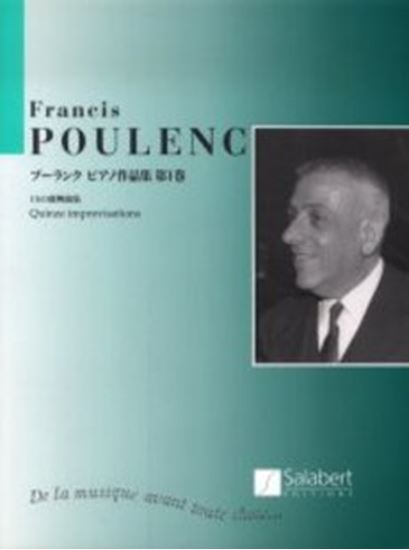Poulenc, Francis : 15 Improvisations
Work Overview
Instrumentation:Piano Solo
Genre:inpromptu
Total Playing Time:24 min 30 sec
Copyright:Public Domain
Commentary (1)
Author : Saitoh, Noriko
Last Updated: June 1, 2008
[Open]
Author : Saitoh, Noriko
Compositions of 1932
No. 1 in B minor, 4/4 time
It begins with a single line spun by both hands, and the texture changes as the piece progresses. There is a brief section where the time signature changes to 2/4.
No. 2 in A-flat major, 3/8 time
A piece primarily characterized by parallel motion between both hands.
No. 3 in B minor, 2/2 time
A piece with diverse textural changes. In polyphonic sections, there are passages where the role of each voice is clearly delineated, and others where they rapidly interchange. There are also sections in unison. Near the end of the piece, a single measure of 1/2 time is briefly inserted.
No. 4 in A-flat major, 4/4 time
A piece written on three staves. It also covers a wide range of pitches. The indication 'Presto con fuoco' at the beginning and the predominantly long note values in the lowest voice contribute to the piece's rich sonority. Additionally, there are brief sections where the time signature changes to 2/4 or 5/4.
No. 5 in A minor, 4/4 time
The melody of this piece is chromatic. It is primarily written polyphonically, but employs a technique where a single note is shared by multiple voices. Furthermore, there are brief sections where the time signature changes to 2/4 or 3/4.
No. 6 in B-flat major, 2/2 time
A piece with interesting rhythms. The sonorities change briskly with such rhythms.
Compositions of 1933
No. 7 in C major, 4/4 time
A piece whose style, characterized by melodic arcs of varying sizes, evokes Fauré. This melody contains moderately chromatic movement. It also suggests a connection to the 1927 'Novelette No. 1'. Additionally, there are brief sections where the time signature changes to 2/4 or 3/4.
Compositions of 1934
No. 8 in A minor, 2/4 time
The melody characteristically employs dotted rhythms and chromatic movement. It concludes by ascending an arpeggiated seventh chord, followed by a single staccato pluck in the bass.
No. 9 in D major, 2/4 time
The melody of this piece is primarily based on disjunct intervals, adorned with chromatic embellishments. Staccato and 'two-note slurs' are frequently used. Furthermore, there is a brief section where the time signature changes to 3/4.
No. 10 'Homage to Scales' in F major, 4/4 time
Literally, a piece that makes extensive use of scales. It is primarily composed of three voices, and each voice handles scales. However, the points of change in these scales differ for each voice. Consequently, one can appreciate the interesting sonorities created by the scales combined in this manner. Additionally, there is a brief section where the time signature changes to 2/4.
Compositions of 1941
No. 11 in G minor, 4/4 time
A piece where a melody sung by chords is accompanied by bouncing arpeggiated octaves.
No. 12 'Homage to Schubert' in E-flat major
In this piece, Poulenc pays homage to Schubert through a waltz. It is a short piece suitable for a recital encore.
Compositions of 1958
No. 13 in A minor, 3/4 time
A piece whose style evokes the melancholic mood of 'Novelette No. 3', which was not yet completed at this time. The melody of this piece, while imbued with pathos, is sung with a light touch. It is accompanied by an accompaniment that covers a wide range of pitches.
No. 14 in D-flat major, 6/8 time
Primarily written in three voices. It covers a wide range of pitches with curving lines. Additionally, there is a brief section where the time signature changes to 3/8.
Compositions of 1959
No. 15 'Homage to Edith Piaf' in C minor, 3/4 time = 9/8 time
As the title suggests, it is an homage to Edith Piaf. A songful piece with a sweet and poignant, swirling melody. The lowest voice creates a subtle duet with the melody, sometimes moving in contrary motion and sometimes supporting it with long note values.
Movements (15)
PTNA & Partner Channel Videos(17items) View More
Sheet Music
Scores List (6)

(株)ヤマハミュージックエンタテインメントホールディングス

(株)音楽之友社

(株)全音楽譜出版社

サラベール社

(株)ヤマハミュージックエンタテインメントホールディングス

(株)全音楽譜出版社








